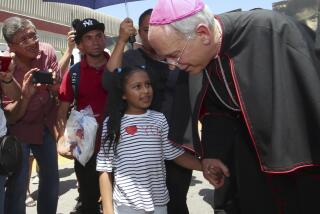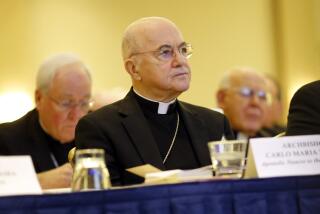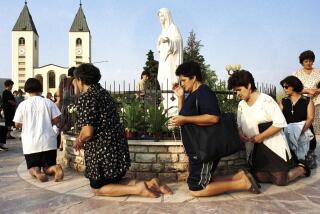Pope Gives Top Post to American; Sainthood for John Paul Hastened
VATICAN CITY — Pope Benedict XVI on Friday named Archbishop William J. Levada of San Francisco to succeed him as the top enforcer of church doctrine, making the 68-year-old prelate the most powerful American at the Vatican.
Benedict also announced he had officially put the late Pope John Paul II on the fast track to sainthood.
Levada, a conservative fourth-generation Californian well-versed in both church bureaucracy and pastoral practice, will become prefect of the Congregation for the Doctrine of the Faith, the office that the former Cardinal Joseph Ratzinger headed with a firm hand for 24 years before his election as pope April 19.
The appointment of Levada, who had also previously served in the doctrinal office, appears to be further confirmation that the new pope intends to hew rigorously to strict, traditional positions on faith and theology. It may also signal sharper attention to the troubled Roman Catholic Church in America.
“The fact that the pope has chosen me, an American, suggests to me that the internationalization of the Roman Curia ... is underway and is not going away,” Levada said at a San Francisco news conference.
He expressed “profound gratitude” for his selection and said the pope had told him that “continuity” was among the reasons he was chosen. “To be able to have someone come in who doesn’t need a long learning curve, that will help the church all over,” Levada said.
Benedict, speaking Friday to a gathering of Rome-based clerics, said he had ordered the immediate launch of the process that opens the way for the beatification and eventual canonization of John Paul. The order, released later by the Vatican, is dated Monday.
Traditionally, a person cannot be considered for beatification, the first step to sainthood, until five years after his or her death. But since John Paul’s death, a campaign has been underway to make an exception for him. Youth groups waved signs declaring “Sainthood Now” and chanted “Saint! Saint!” at his April 8 funeral Mass, and several cardinals expressed support for an expedited process.
Announcing his plans, the German-born Benedict cited “the extraordinary experience of faith” brought on by his predecessor’s death and said John Paul had left a church “profoundly united, full of life and rich of fervor.”
“Time to be in the presence of God is a true pastoral priority,” Benedict said. “In the final analysis, [it is] the most important priority. John Paul II demonstrated this to us in the most tangible and luminous of ways in all the circumstances of his life and his ministry.”
Only once before has the five-year waiting period been waived: for Mother Teresa of Calcutta. The lengthy process was initiated in 1999, 18 months after her death; she was beatified in 2003 by John Paul.
Under the church’s rules, a miracle attributed to John Paul and performed after his death will have to be documented for the Polish-born pontiff to be beatified; a second posthumous miracle is necessary to be named a saint. Usually events deemed as miracles involve unexplained medical cures.
Although Benedict has expedited the case, the process still could take years. An exhaustive compilation of John Paul’s life history and writings also must be gathered.
Benedict delivered what he called the “joyous piece of news” during a speech at Rome’s largest church, St. John Lateran Basilica. Priests stood and clapped, and then the pope also joined in the applause.
The naming of Levada as doctrinal watchdog had been rumored for weeks.
Levada worked inside the Vatican’s doctrinal office for years before moving back to the United States in the early 1980s and later becoming Archbishop of Portland, Ore., and then San Francisco. He was among the first people to be granted a private audience with the new pope, which fueled speculation about an appointment.
The office is traditionally headed by a cardinal, so it appears likely that Benedict will elevate Levada at his first round of appointments, possibly as early as late June.
The two men are old friends and, by most accounts, share similar conservative views.
Levada has spoken out frequently against same-sex marriage as head of the diocese in liberal San Francisco, which has a large gay population. But he has also called for homosexuals to be treated “with compassion and respect.”
He also waded into one of the hot-button issues of recent American politics, saying that the church should not have a blanket ban on Communion for politicians who support abortion rights and that the matter should be decided individually by priests and their bishops.
Levada was born in Long Beach and completed seminary studies in Rome. He went on to earn a doctorate in sacred theology at the prestigious, Jesuit-run Pontifical Gregorian University, also in Rome. In his early years as a priest, Levada worked in the parishes of Los Angeles and taught high school.
He served as the only U.S. bishop on a Vatican committee that rewrote the church catechism, writing a glossary in English.
Under Ratzinger, the doctrinal office, known as the Inquisition until 1908, cracked down on dissent within the church, disciplined priests and nuns said to have strayed from orthodox teachings and asserted the primacy of Catholicism over other faiths.
Levada assumes the job at a time when the Roman Catholic Church, especially in the United States, is being buffeted by sensitive social issues, including allegations of sexual abuse by priests. He served on a Vatican task force, shared with the U.S. Conference of Catholic Bishops, that devised the rules for dealing with sexual abuse cases.
A U.S. organization, the Survivors Network of Those Abused by Priests, protested Levada’s appointment, saying he had been slow to punish abusive priests, unkind to victims and secretive in handling the cases.
On Friday, about 15 members marched outside the archdiocese building in San Francisco, carrying placards accusing Levada of covering up abuse allegations.
“He’s known for secrecy, cover-up and denial,” said Terrie Light, a national board member of the group. “We also feel he’s not been responsive.”
Levada rejected the cover-up charges. “Those accusations are certainly off the mark,” he said during his news conference. “People will say what they have to say, trying to accuse bishops, me, of malfeasance.”
Despite Levada’s theological conservatism, the appointment of an American to a pivotal role in Benedict’s pontificate was seen as a hopeful sign by some moderates within the church.
Father Thomas P. Rausch, professor of theology at Loyola Marymount University in Los Angeles, was among them. Rausch, a Jesuit, said theologians had been worried, particularly since Father Thomas J. Reese was forced last week to step down as editor of the Jesuit magazine, America.
Under the former Cardinal Ratzinger, the doctrinal office had repeatedly protested the magazine’s publication of points of view that questioned or opposed the church’s official teaching on such issues as the role of women, ecumenical relations and whether Catholic politicians who support the right to abortion should be barred from receiving Communion.
“Theologians are worried if these are signs that theologians can no longer discuss controversial issues in the church,” Rausch said.
“I think they would welcome an American. Americans are used to a public discussion of issues. That’s part of our culture. That doesn’t mean they’re being disloyal because they’re raising questions and asking about different ways of seeing things in light of new circumstances.
“I think if there was an American at the congregation, I think he would be more appreciative of the American way of proceeding.”
In 1992, as the nation’s Catholic bishops reached an impasse with the Vatican over a controversial position they had drafted on the role of women in the church, Levada was among those chosen to tone down the language. They hoped that as a conservative and a theologian, his involvement would assuage concerns in Ratzinger’s office.
Earlier versions of the pronouncement, in the works for almost a decade, condemned the “sin of sexism” and said that women should be treated equally.
Cast in the form of a proposed pastoral letter to the American church, it also urged consideration of ordaining women to the deaconate and said women’s experiences would contribute to church understanding on sexuality.
But it also upheld John Paul’s views that women should be barred from the priesthood. There are three ordained offices or orders in the church: deacons, priests and bishops.
Ratzinger thought the revisions were not clear enough about the ban on female priests and that its inclusive language, avoiding gender-specific words, went overboard, according to a book by Vatican journalist John L. Allen Jr.
“By the time Levada’s version came up for a vote in November of 1992, the document had moved so far to the right -- condemning the sexual revolution, forms of feminism and laws that treat men and women alike -- that many women hoped the bishops would drop the entire project,” Allen wrote.
Sister Maureen Fiedler, a leader of Catholics Speak Out, which advocates change in the church, told the Los Angeles Times this week, “It got progressively weaker and worse as it went along.”
*
(BEGIN TEXT OF INFOBOX)
Path to sainthood
The call for the beatification of Pope John Paul II starts the Roman Catholic sainthood process, which can take years to complete. How it works:
Request: A call is made for beatification, which requires that a miracle has been attributed to the person after his or her death.
Investigation: Historians and theologians investigate the person’s life, gathering personal writings and teachings and conducting interviews.
Examination: The Congregation for the Causes of Saints examines the submitted material for orthodoxy and heresy.
Beatification: Upon two-thirds approval, the case is presented to the pope for approval. Beatification bestows the title of “Blessed.”
Canonization: Proof of a second miracle after the candidate’s death is required for sainthood, which declares the person virtuous and worthy of veneration. Canonization bestows the title of “Saint.”
Sources: AP, AFP, BBC
Graphics reporting by Brady MacDonald
*
Wilkinson reported from Vatican City and Stammer from Los Angeles. Times staff writer Maria L. La Ganga and special correspondent Donna Horowitz in San Francisco contributed to this report.
More to Read
Sign up for Essential California
The most important California stories and recommendations in your inbox every morning.
You may occasionally receive promotional content from the Los Angeles Times.











